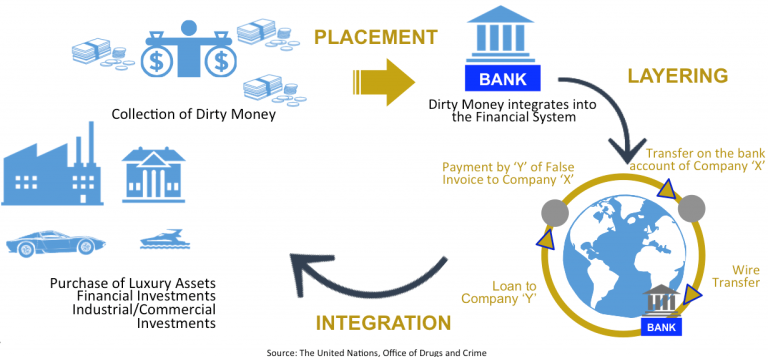The following information is an extract from the sources cited at the end. All rights of the following information belongs to them.
What is Anti-Money Laundering?
Anti-Money Laundering is when criminal proceeds are taken, and their illegal source is disguised to fund legal or illegal activities. In Simple terms, making dirty money look clean.
When a criminal activity generates considerable amount of profit, individual or group involved must find a way to disguise it to avoid any unnecessary attention as the principal activity from which these funds were derived from was illegal. The form of source of fund is usually changed or moved to another place where its less likely to attract attention and be caught. Criminal activities that can lead to money laundering are can include illegal arms sales, narcotics trafficking, contraband smuggling and other activities related to organized crime, embezzlement, insider trading, bribery and computer fraud schemes.
Financial Action Task Force (FATF) was founded in 1989 by seven industrialized nations to set and bring forth international standard of compliance against money laundering. One of FATF’s earlier notion was that money laundering is only about cash transactions. However, over time that notion has changed and now we can say with confidence that money laundering can be achieved via every medium, financial institution or business.
The United Nations 2000 Convention Against Transnational Organized Crime, also known as the Palermo Convention, defines money laundering as
• The conversion or transfer of property, knowing it is derived from a criminal offense, for the purpose of concealing or disguising its illicit origin or of assisting any person who is involved in the commission of the crime to evade the legal consequences of his or her actions;
• The concealment or disguise of the true nature, source, location, disposition, movement, rights with respect to or ownership of property knowing that it is derived from a criminal offense; and
• The acquisition, possession or use of property, knowing at the time of its receipt that it was derived from a criminal offense or from participation in a crime.
Three Stages of Money Laundering Cycle:
Stage One: Placement – The physical disposal of cash or other assets derived from criminal activity.
During the placement phase, illicit proceeds are introduced by the money launderer into the financial system. Often through casinos, formal financial institutions and other legitimate businesses, both domestically and internationally.
Examples of placement transactions include the following:
• Blending of funds: Commingling of illegitimate funds with legitimate funds, such as placing the cash from illegal narcotics sales into cash-intensive, locally owned restaurant
• Foreign exchange: Purchasing of foreign exchange with illegal funds
• Breaking up amounts: Placing cash in small amounts and depositing them into numerous bank accounts in an attempt to evade reporting requirements
• Currency smuggling: Cross-border physical movement of cash or monetary instruments
• Loans: Repayment of legitimate loans using laundered cash
Stage Two: Layering – The separation of illicit proceeds from their source by layers of financial transactions intended to conceal the origin of the proceeds.
The Layering phase involves converting the proceeds of the crime into another form and creating complex layers of financial transactions to obfuscate the source and ownership of funds.
Examples of layering transactions include:
• Electronically moving funds from one country to another and dividing them into advanced financial options and/or markets;
• Moving funds from one financial institution to another or within accounts at the same institution;
• Converting the cash placed into monetary instruments;
• Reselling high-value goods and prepaid access/stored value products;
• Investing in real estate and other legitimate businesses;
• Placing money in stocks, bonds or life insurance products; and
• Using shell companies to obscure the ultimate beneficial owner and assets.
Stage Three: Integration – Supplying apparent legitimacy to illicit wealth through the reentry of the funds into the economy in what appears to be normal business or personal transactions.
This stage entails using laundered proceeds in seemingly normal transactions to create the perception of legitimacy. The launderer, for instance, might choose to invest the funds in real estate, financial ventures or luxury assets. By the integration stage, it is exceedingly difficult to distinguish between legal and illegal wealth. This stage provides a launderer the opportunity to increase his or her wealth with the proceeds of crime. Integration is generally difficult to spot unless there are great disparities between a person’s or company’s legitimate employment, business or investment ventures and a person’s wealth or a company’s income or assets.
Examples of integration transactions include:
• Purchasing luxury assets, such as property, artwork, jewelry or high-end automobiles;
• Getting into financial arrangements or other ventures where investments can be made in business enterprises

Above references from CAMS Certification Study Guide
